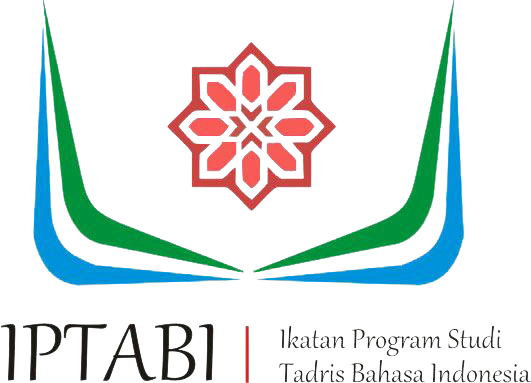Kajian Strukturalisme dalam Puisi Surat dari Ibu Karya Asrul Sani
DOI:
https://doi.org/10.29240/estetik.v4i1.2368Keywords:
Literature, Poetry, Structuralism StudiesAbstract
This study uses the object of the literary work of poetry "Surat Dari Ibu", by Asrul Sani by using structuralism studies. The purpose of this study is to describe the physical elements and mental elements as a whole which allows to provide new knowledge to the reader. This study uses a qualitative approach to the method of content analysis in poetry. The results obtained in the physical structure of the poem there are 2 dictions related to the choice of words used by the poet. Images / images found 3 images related to the human senses. In concrete words there are 2 related to the overall meaning of the word. There are 2 styles of language, namely comparative figure of speech and affirmation figure of speech. Rima uses free rhyme in his poetry. The last physical element is typography, the poet uses typography in upper and lower case letters and full punctuation in his poetry. The inner element contained in the poem Surat Dari Ibu, Asrul Sani's first work, is the theme of finding a stanza related to the problems in poetry. Based on the tone found 2 tones. The inner element in feeling is found to be a sense of emotion and hope from a mother in the poem Surat Dari Ibu, by Asrul Sani. The last inner element is the mandate, there is one message that the poet wants to convey through his poetry
Downloads
References
Gunta Wirawan. “Analisis Struktural Antalogi Puisi Hujan Lolos di Sela Jari Karya Yudishwaraâ€. Jurnal Pendidikan Bahasa dan Sastra Indonesia. Vol. 1, No. 2 (2016).
Nori A dan Nurlaely A. “Analisis Struktural pada Puisi Malu Aku Jadi Orang Indonesia, Karya Taufik Ismail (Pendekatan Struktural). Jurnal Sasindo Unpam. Vol. 8, No. 1 (2020).
Sri W.Y dan Mohd H. “Analisis Fisik Dan Batin Puisi Anak Dalam Majalah Potret Anak Cerdasâ€. Jurnal Master Bahasa. Vol. 6, No. 2 (2018).
Muakibatul H. “Karakteristik Struktural-Semiotik Puisi-Puisi Karya D. Zawawi Imronâ€. Jurnal Litera. Vol. 12, No. 2 (2013).
Chikita C.P.P, dkk. “Analisis Unsur Pembangun Dalam Kumpulan Puisi Segenggam Cinta Untuk Sang Maha Cinta Karya M. Saidati Sebagai Bahan Ajarâ€. Jurnal Pendidikan Bahasa dan Sastra Indonesia. Vol. 4, No. 1 (2019).
Nursalim. “Simbolisasi Puisi Padamu Jua Karya Amir Hamzah Dari Kajian Semiotikâ€. Jurnal Bahastra. Vol. 3, No. 1 (2018).
Muhammad M, dkk. “Analisis Struktur Diksi Pada Puisi Padamu Jua Karya Amir Hamzahâ€. Jurnal Parole. Vol. 1, No. 4 (2018).
Susri Inarti. “Analisis Intertekstual Puisi Dongeng Sebelum Tidur Karya Goenawan Mohamadâ€. Jurnal Metasastra. Vol. 6, No. 1 (2013).
Budi S.P dan Dida F. “Analisis Semiotika Pada Puisi Barangkali Karena Bulan Karya WS. Rendraâ€. Jurnal Parole. Vol. 2, No. 2 (2019).
Deden M.D. “Semiotika dalam Puisi Hujan Bulan Juni Karya Sapardi Djoko Damonoâ€. Jurnal Membaca. Vol. 3, No. 1 (2018).
Suyono Suyotno. Antologi Puisi Indonesia Modern Anak-Anak. Yayasan Obor Indonesia. 2003.
Downloads
Published
How to Cite
Issue
Section
Citation Check
License
Copyright (c) 2021 Syarifah Rahmah, Hidayah Budi Qur'ani

This work is licensed under a Creative Commons Attribution-NonCommercial-ShareAlike 4.0 International License.
Authors who publish with ESTETIK : Jurnal Bahasa Indonesia agree to the following terms:
- Authors retain copyright and grant the journal right of first publication with the work simultaneously licensed under a Creative Commons Attribution-NonCommercial-ShareAlike 4.0 International License (CC BY-NC-SA 4.0) that allows others to share the work with an acknowledgment of the work's authorship and initial publication in this journal.
- Authors are able to enter into separate, additional contractual arrangements for the non-exclusive distribution of the journal's published version of the work (e.g., post it to an institutional repository or publish it in a book), with an acknowledgment of its initial publication in this journal.
- Authors are permitted and encouraged to post their work online (e.g., in institutional repositories or on their website) prior to and during the submission process, as it can lead to productive exchanges, as well as earlier and greater citation of published work (See The Effect of Open Access).






